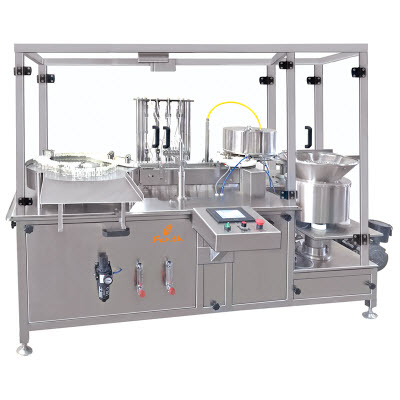For Export Enquiry
Call Us
How Injectable Liquid Filling Machines Enhance Efficiency in Vaccine Production?
Injectable liquid filling machines play a crucial role in vaccine production, streamlining processes and enhancing efficiency at various stages. Here's a step-by-step guide on how these machines contribute to the efficient production of vaccines:
Step 1: Preparation of the Vaccine Formulation
Before the filling process begins, the vaccine formulation must be prepared according to the specific requirements of the vaccine. This involves mixing the active ingredients, adjuvants, and stabilizers under controlled conditions to ensure uniformity and stability of the final product.
Step 2: Sterilization of the Filling Equipment
To prevent contamination and ensure the safety of the vaccine, all parts of the liquid filling machine that will come into contact with the vaccine are sterilized. Typically, methods such as steam sterilization, chemical sterilization, or UV irradiation are used depending on the sensitivity of the materials and the specific requirements of the vaccine.
Step 3: Setup of the Injectable Liquid Filling Machine
The liquid filling machine is set up to handle the specific type of vaccine container, commonly vials or syringes. The machine settings are adjusted for the volume of liquid to be filled, the size of the container, and the speed of the filling process. This setup is crucial to ensure accuracy and precision in the filling process.
Step 4: Filling of Vaccine into Containers
Once the machine is set up and the vaccine is prepared, the filling process begins. The vaccine is pumped from a holding tank through sterilized pipes to the filling station where it is dispensed into containers. The filling machines are equipped with precision pumps and nozzles that ensure each container is filled with the exact amount of vaccine required, minimizing waste and ensuring consistency.
Step 5: Stoppering and Sealing of Containers
After the vaccine is dispensed into the containers, they are immediately stoppered and sealed to maintain sterility. The stoppering and sealing process is often integrated into the liquid filling machine, allowing for seamless transition from filling to sealing. This reduces the risk of contamination and ensures that the vaccine remains sterile until it reaches the end user.

Step 6: Quality Control and Inspection
Following the stoppering and sealing, the filled containers undergo a series of quality control checks. This includes checking for proper fill volume, ensuring the integrity of the seal, and verifying sterility. Advanced filling machines may include automated inspection technologies that use cameras and sensors to detect any defects or irregularities.
Step 7: Labeling and Packaging
The final step in the process involves labeling the vaccine containers with relevant information such as the type of vaccine, batch number, expiration date, and storage instructions. The containers are then packaged into boxes or crates for distribution. This step is often automated and integrated with the filling line to maintain efficiency and accuracy.
Step 8: Clean-up and Maintenance
After the filling process is complete, the machine undergoes a thorough cleaning to remove any residues and prevent cross-contamination between batches. Regular maintenance is also performed to ensure that the machine remains in optimal working condition and is ready for the next production run.
Step 9: Documentation and Compliance
Throughout the filling process, detailed records are kept of all operations, including batch numbers, machine settings, and quality control results. This documentation is crucial for regulatory compliance and traceability, ensuring that the vaccine production process meets all legal and safety standards.
Injectable liquid filling machines significantly enhance the efficiency of vaccine production by automating critical steps, reducing manual labor, and increasing the accuracy and speed of the filling process. These machines enable vaccine manufacturers to produce high-quality products quickly and consistently, meeting the urgent demand for vaccines, especially in times of public health emergencies.
We provide 24 x 7 Customer
Service & Support
Copyright © 2025, Parth Engineering & Consultant ( India ).
Web Design by Opal Infotech





